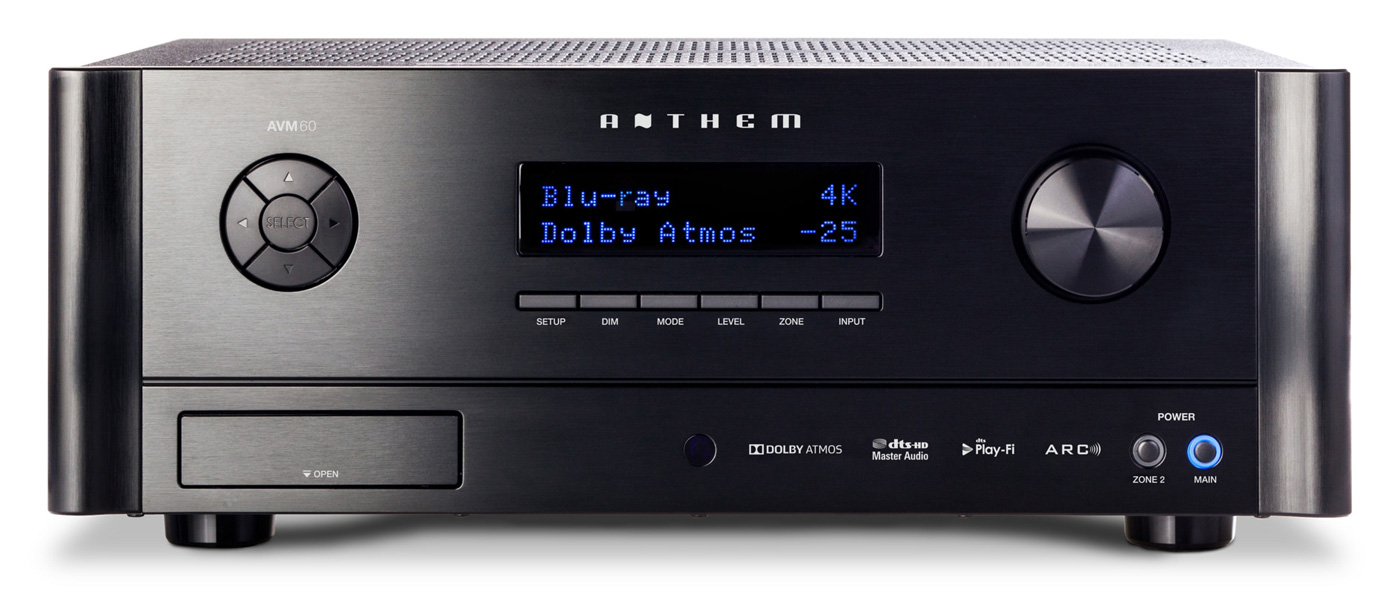This would be digital surround sound of course but also the analog audio performance, even in bypass mode with two channels driven. The Maestro M9 includes the full version of Dirac Live which is a top room-correction package. It also had pristine video pass through with 4K and HDR functionality.
AudioControl did not skimp on the design and internal componentry which leads to a somewhat high price. In this case, you get what you pay for.
AudioControl Maestro M9 Surround Sound Processor
- Dolby Atmos (up to 7.1.4) and DTS:X included
- 4K and 3D video passthrough with full HDR support
- Dirac Live room correction
- Individual Burr Brown DAC’s
- Robust power supply
- Custom installation control ready (Savant, Control 4, Elan, Crestron and AMX)
AudioControl has been around for 40 years now. I first heard of them because of some nifty equalizers and bass restoration components they produced in the early days. Back then, these products would typically be introduced to your system in a recording loop on you preamplifier. Everything was analog then and AudioControl learned a lot about analog circuit design.
Codecs:
Dolby Atmos, DTS:X, Dolby Surround, DTS-HD Master Audio, DTS-ES 6.1 Discrete, DTS-ES 6.1 Matrix, DTS 5.1
Inputs:
HDMI (7 Total, 1 MHL Compatible), SPDIF Coax (4), Toslink (2), Analog RCA (6), 3.5 mm Aux (1), USB (1)
Outputs:
HDMI (2 Zone 1 [1 ARC Enabled], 1 Zone 2), 7.2.4 Pre-amp output (Main Channels Balanced, Height Channels Unbalanced RCA), Zone 2 Stereo (Unbalanced RCA)
Control Drivers Available:
Savant, Control 4, Elan, Crestron and AMX
2-Zone:
Operation
AM/FM:
Tuner
Signal to Noise (MFR):
110 dB (A-Weighted, Analog Bypass)
Frequency Response (MFR):
20Hz-20kHz ± 0.2 dB
Total Harmonic Distortion (MFR):
-100dB
Dimensions:
16.5”D x 17”W x 7”H (4U)
Weight:
42.0 Pounds
MSRP:
$8,900 (USD)
Company:
SECRETS Tags:
AudioControl, Maestro M9, Surround Sound Processor, Processor Reviews 2017
Although AudioControl makes some really cool audio products for the home, they are probably best known for car audio with processors such as the AudioControl Epicenter as well as converters, amps and other accessories. And now they have a growing and well respected pro audio group.
On the home audio front, AudioControl’s products cover a wide range of categories from massive multi-channel amps like the Savoy G3 to small accessory amps for distributed audio. The lineup also includes some impressive surround receivers and processors.
The Maestro M9 is AudioControl’s latest surround processor and it contains the most significant technologies at the forefront of home cinema. I had the chance to spend quite a bit of time with it and my full review is presented below.
The AudioControl Maestro M9 is AudioControl’s newest home cinema surround processor and is the sixth generation in the Maestro line of surround processors. It is a well-designed product with excellent build quality and high-end internal components. It naturally handles all the latest surround codecs to include Dolby Atmos and DTS:X.
This is the second processor I have reviewed that features Dolby Atmos and the first with DTS:X. So this was my first chance at a sort of side by side comparison between the two formats. Looking back in time, it was not long ago that Dolby Digital was the king of the hill. This was back when DVD was the predominate consumer format. Dolby Digital became ubiquitous despite the fact that many cinephiles preferred the sound of DTS. But Dolby’s dominance started to erode as Blu-rays came to the fore. A majority of Blu-ray discs now have DTS-HD Master as opposed to Dolby TrueHD Lossless. There are a lot of reasons why this would be the case ($) though I won’t go into them here. Suffice it to say that DTS has been seriously gaining ground on Dolby in the age of Blu-rays.
But now that I have heard both Dolby Atmo sand DTS:X in a direct comparison over my own home audio system, I feel that Dolby may very well reclaim the mantle. Dolby Atmos recordings create a more convincing surround bubble with a much more homogeneous directionality. The individual channels simply melted away much more so than with DTS:X.

Apologies for that diversion, why don’t I get back to discussing the AudioControl Maestro M9’s design?
This is a well put together unit, with a strong all-metal case that is of heavy gauge forged steel (even the top of the case is heavy). It has large openings in the case to promote cooling of the internal components. These large openings offer an interesting view of the inside of the case. You see, the case needs to be pretty big to accommodate all the back panel jacks. And also to allow for amplification as their receivers use the same case. The view inside was “interesting” because all the vacant space left behind by the non-existent power amp section which gave me the feeling that the product was “incomplete” but it most certainly was not.
Secrets Sponsor
What all this extra space does allow was a clear view of the substantial toroidal transformer. This transformer was bigger and heavier than ones I see in a lot of mass market receivers and the Maestro M9 doesn’t have any power amplification stage! AudioControl has informed me that this transformer is rated at 800 VA! I love it when a component has a substantial power supply like this – it promotes dynamic, low-distortion playback about as much as any other single design and implementation aspect of an audio product. And this is a large toroid versus an EI transformer so it exhibits all the inherent advantages of its advanced design.
The front panel has 10 buttons and a volume knob. These can control virtually everything the Maestro M9 is capable of doing except for turning the unit on or off. Toggling the power on and off must be done via the remote or by way of IP or serial port control if you have a theater control and integration system. This doesn’t sound like a big deal, but it was a problem for some of my family members who would wind up leaving the thing on overnight, etc.
Also on the front panel are a blue dot matrix two-line readout, a mini headphone jack, a mini plug for auxiliary input and a power status LED. I do wish the Maestro M9 had front panel HDMI and USB inputs as these get used around here quite regularly.

AudioControl produces the Maestro M9 in two versions – gloss black with gold tone lettering or an “espresso” black with white lettering. My review unit was the espresso black model and it was indeed a handsome looking piece of kit albeit a little on the utilitarian side of things.
The AudioControl Maestro M9 comes complete with a full version of Dirac Live for AudioControl. I will discuss this in more detail in the Setup Section below but, in a nutshell, Dirac Live is a room correction system that not only corrects for proper frequency balance but it also manages to correct certain impulse response anomalies. Dirac Live is scalable from a small system all the way up to a large screening room. It is one of my favorite room correction packages that are available on the consumer market.
Secrets Sponsor
The Maestro M9 includes a high quality AM/FM tuner. You can also listen to network streaming and internet radio via the rear panel Ethernet hook up (no built-in WiFi). Once you connect your Maesto M9 to your home network, it can then be controlled by iOS devices via a slick app.
On the audio side, there are some omissions that may be a concern for a portion of consumers – the AudioControl Maestro M9 does not decode DSD signals and doesn’t do computer audio over USB. This is not a concern to me and it really shouldn’t be for you either. DSD, though highly regarded by many, is hampered by extreme high frequency noise that puts an undue burden on your electronics and speakers. It is my opinion that this leads to audible distortion. PCM is not plagued with this issue.
On the computer audio over USB point, I would stress that the Maestro M9 is primarily built and marketed as a home cinema product and though it does perform magnificently on music, it has limited aspirations as a stereo product. So, do like me and get an OPPO Blu-ray player that has DSD and USB. Playback over analog to your AudioControl Maestro M9. The audible results will really wake up your senses!
The Maestro M9 is 4K ready and supports HDCP2.2 protocols including full HDR support. Its HDMI 2.0a interface is 3D compliant as well and includes Audio Return Channel (ARC) functionality. There are plenty of ins and outs with 7 HDMI inputs and three outputs.
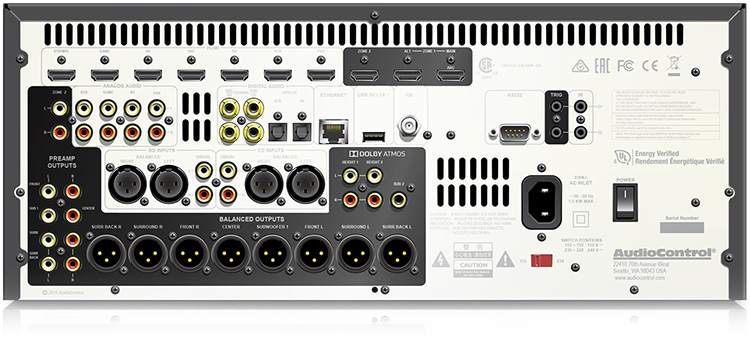
The processor’s back panel layout is clean, reasonably uncluttered and logically laid out. The HDMI board is along the top and is where you will find the 7 inputs and two main outputs. There is an additional Zone 2 HDMI output which is a nice plus.
There are 6 analog inputs and outputs, two of which feature the option to use balanced inputs (CD and BD). S/PDIF coax and optical inputs are nestled in this cluster of jacks and are easily identified because of the high contrast lettering on the back panel. There is a USB port here that is for playing files from a jump drive or a hard drive. As discussed previously, it is not for computer audio. Also on this row are the Ethernet port, 75 ohm antenna jack and the various control ports which include four programmable DC triggers.
The main outputs are on the bottom. All channels have unbalanced RCA outs while there are also 8 balanced outs for the main channels (7.1). One nice feature is that the surround back balanced outputs can be re-routed as height speakers if you have a 5.1.2 set up like mine.
I hooked up the AudioControl Maestro M9 in the usual way. In recent years, almost all my source components are connected via HDMI. I do have a few components where I make some analog connections: for example, my phono stage and my OPPO Blu-ray player. The Maestro M9 allows the user to connect a component with both digital and analog hook ups and then you can select which one to enjoy during playback. This is how I connect my OPPO BDP 105D and it allows me to bypass the DAC’s in the Maestro M9 which (in theory) may provide improved audio performance for music listening. And in actuality I do use the OPPO for computer audio over asynchronous USB.
On the video side, I have two displays: a direct view monitor and a front projector which can both be connected to the two individual HDMI outputs of the Maestro M9. Both of these outputs are active at all times. This makes life easier because there is no need to switch the output when switching displays.
The Maestro M9 must be connected to your home network via Ethernet so you can calibrate the audio using Dirac Live. You should also keep it connected to the ‘net to take advantage of audio streaming, internet radio and iOS control.
I do not have a home automation system nor do I have multiple zones in my house. So I didn’t utilize any of these features and their associated hook ups for this review. I would like to say that AudioControl is and should be a darling among custom installation purveyors. I think they sell a lot of these units through these supply chains for several reasons such as . . . products that are built with the custom installer in mind, reliability of their products, excellent customer service and superior performance qualities.
Audio output-wise, I connected the 5.1.2 balanced connections to my ATI 7-channel amp and my SVS SB 13 Ultra sub.

Once everything was hooked up and ready to go, I was ready to calibrate. The set up for Dirac Live is probably a challenge for some but I personally find it to be quite logical and straight forward. The Maestro M9 unit comes with a USB sound card and an analog mic that you connect to a laptop on which you have downloaded the Dirac Live for AudioControl software. You then connect the receiver to the same network via its Ethernet connection. The laptop and receiver need to be on the same network. Once all the connections are made, you launch the software on the laptop and follow the script-based calibration process.
This process walks you through the basic calibration to the Dirac Live default target curve. It gets a little more complex if you want to tailor your own custom response curve. I have gotten to where I rarely do this but from time to time, I truncate the correction to only act on the bass region that would be most affected by room response and leave the speakers to their native response above 300 Hz or so.
My first attempt to calibrate the AudioControl Maestro M9 didn’t work out. Every satellite speaker reflected an unusual, high-Q peak in the treble region that does not in fact exist. This peak was about +15 dB at 10 kHz. My first thought was that there must be something amiss with the USB sound card. So AudioControl promptly shipped me a new sound card and mic combo.
That did not fix the problem and AudioControl wound up sending me a whole new Maestro M9 unit which worked perfectly. I do not see this as a major issue because AudioControl handled it quickly and let’s face it, complex electronics sometimes have issues due to their very complexity. Such issues usually show up early in the life of the product. And in the rare case that the problems may rise up at a later date, no worries because AudioControl offers a full 5-year warranty!
Once I finished the calibration, I generally evaluated the Maestro M9 using the default curve. I did manually set the delays and channel balance after Dirac Live was done. These manual adjustments substantially improved the immersion factor. So now I was ready to enjoy some movies and music!
Once I had everything set up and calibrated, I settled in for a long evaluation period. I will say right here and now that I enjoyed my time with the AudioControl Maestro M9 about as much as any other surround processor I have owned or evaluated. I have experience with some very pricey products and the AudioControl did an excellent job holding its own in comparison to these other products.
One of the most salient categories was the way the AudioControl created a seamless surround bubble. This distinction became apparent as soon as I put my reference SSP back in the system at the conclusion of this review. It was at that moment when I realized more than ever that the Maestro M9 was able to localize sounds in my theater with little regard to where the speakers were placed. With my old SSP, I could close my eyes and point to each speaker. With the AudioControl, I could not do this.

One movie that clarified this observation for me was Rogue One. This excellent work is mastered on Blu-ray with a DTS HD Master 7.1 sound track. I listened to the first half of the film in this format and then switched to the Dolby Surround mode which derives height channels from the DTS audio track.
This effect was a real treat and added a dimension of envelopment that was simply absent with the native soundtrack. This is one of the best features of the AudioControl Maestro M9 – its ability to render height information from just about any source possible. And as discussed above, it does this as seamlessly as one could imagine.
I didn’t altogether care for the bass integration on this movie and played around with the settings, finding a better quality of sound when I ran my mains as “large”. I went back and forth between large and a 60 Hz crossover throughout the review period and the best choice was typically program-dependent. The better setting for whatever I had on would be heard primarily as improved integration of the bass (which is something that I am very sensitive to.)

There was a time when I had convinced myself that you could have a system that worked equally well for both movies and music. But now I see that I was delusional. Up until very recently, that is. I can now confidently state that a system can perform equally well on movies and music.
This transformation of opinion required decades of experience along with exposure to products like the AudioControl Maestro M9. I think this is because AudioControl does not skimp on the internal components as is commonplace among mass market SSP’s. One great example of the Maestro M9 having chops in the musical arena was the movie Sing.
I was enraptured with the audio and video of this disc from the moment it started playing. To begin with, this movie is done in Dolby Atmos. It is a fine recording. The performances are all very excellent. As a matter of film art, it was easy to root for the characters and the movie has a bit of a dark edge, satirizing modern life. This movie had very few weaknesses.
The Masetro M9, to its credit, stepped aside and let all of that shine through. It was a very immersive experience. Oh, and I played this movie again the other night on my old SSP and I was severely let down with the audio and video in comparison to the prowess of the AudioControl Maestro M9. I think the biggest difference lies in the AudioControl’s re-clocking of the HDMI audio which reduces jitter to immeasurably low levels. Plus the Maestro M9 has Burr Brown DAC’s that are a significant upgrade over many competitors.

There wasn’t much Dolby Atmos material on the market when I first installed in-ceiling height speakers in my theater. So I queried the trusty internet for Atmos titles and came up with this gem – The Rocky Mountain Express. This documentary tells the story of the Canadian Transatlantic rail line. It is in Dolby Atmos and they have a restored steam locomotive in there.
You see where I am going with this? Just give it a screening for yourself and I think you will come away with a better appreciation of what a steam train sounds like all up close and everything. It doesn’t hurt that the scenes of the Rockies are presented in 4K video either.
This disc was another example where the AudioControl Maestro M9 really separated itself from the pack with a magnificent presentation that passed all the power and majesty of the trains, the score, etc. I must admit that from time to time I felt that the Maestro M9 might be a touch soft dynamically with a somewhat indifferent bass response but then a disc like this would come along and I realized the Maestro M9 was not the problem. The “problem” was lesser program material; the Maestro M9 didn’t suffer any of these ailments when I played material with high production values such as The Rocky Mountain Express.
I did test the AudioControl Maestro M9 with 2-channel analog audio both from my OPPO BDP-105D and from vinyl. When compared to the best two-channel preamps, the maestro M9 did tend to flatten the front-to-back layering but, for the most part, the Maestro M9’s ability with analog audio was a refreshing break from the sound offered by most of the competition.

Take the LP of David Bowie’s acclamation, Black Star. I listened with the sub turned off, Dirac Live was off (to avoid A/D D/A conversions) and I set the unit to stereo bypass. What I heard was a very impressive performance at the frequency extremes. The bass was surprising in its weight and pitch definition. The treble was extended with no artificial bite or undue steeliness. This made it easy for me to fall into the music, shirk my responsibilities and just enjoy the music.
The side to side imagery was much better than what I would expect from an SSP while the front to back layering was very good for an SSP but not up to the standards of the best stereo only preamps.
The percussion was lively which meant the unit had good rhythm and pace. All in all, this album over the Maestro M9 gave me goosebumps galore!
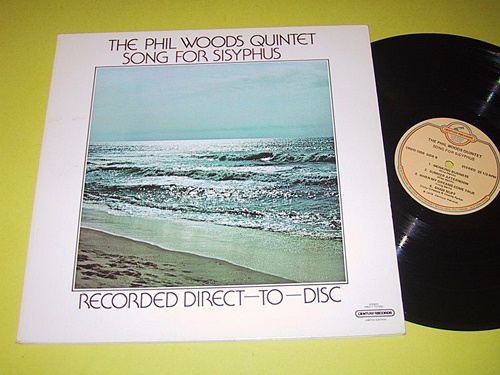
I want to close out by mentioning another LP I have enjoyed over the years, Phil Woods Quintet "Song for Sisyphus". This is a direct to disc vinyl from 1978. This album is a good choice for review as I have listened to it so many times, the performances are mastreful and the recording is above average.
"Change Partners" rocked my socks off. This song buzzed with life and energy. It was that whole rhythm and pace thing again. Once more, I felt much of this boiled down to the way the Maestro M9 rendered the percussion with a very natural tone and transient impact. The Maestro M9 could also separate out individual notes better than 95% of all SSP’s I have reviewed. The sound here really took me back in a most positive way.
The below test plot is the analog frequency response of the AudioControl Maestro M9 through the line level outputs. This was the left channel driven through the CD balanced input to the balanced analog out. The unit was set to stereo direct and the room correction was turned off. The frequency response exhibits a mostly flat response from DC to 20 kHz. There is a useable signal up to 90 kHz at which point a sharp roll off begins. The signal at 90 kHz is less than 5 dB below the signal at 1 kHz.
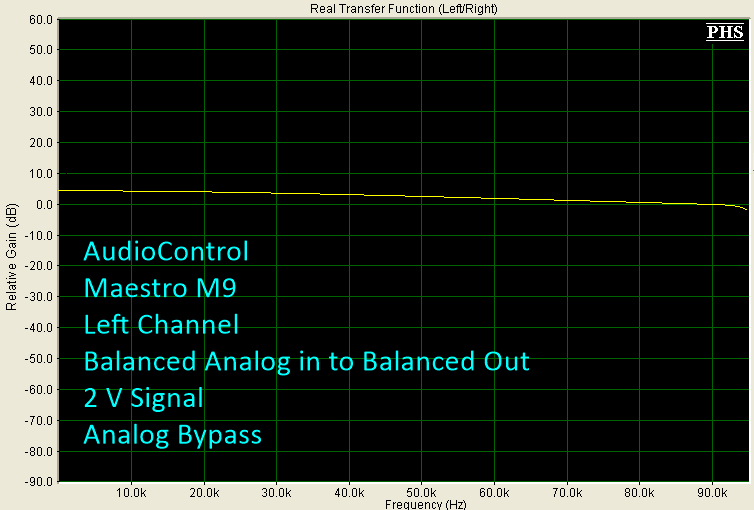
I wanted to test the Dirac Live filtering of the Maestro M9. So I ran the below test in the same set up as described above. But this time, the Dirac Live was engaged. The output signal is the inverse of the room response for the left speaker. The system has some aggressive correction and the corrected curve is multi-faceted which indicates that the Maestro M9 contains a reasonably powerful DSP engine. Note that the signal starts to roll off around 22 kHz which indicates that the A/D to D/A process takes place at a sampling rate of around 44 kHz.
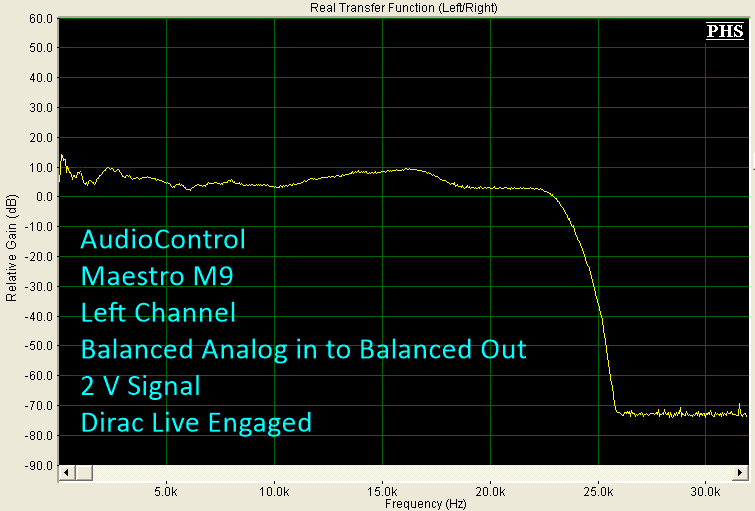
This is the basic THD+N reading for the AudioControl Maestro M9. This test was run through the balanced analog input to the balanced analog out and with Dirac Live disabled (stereo direct). At 2V out, the THD+N is 0.0013%. This is a remarkable test result for a surround processor.
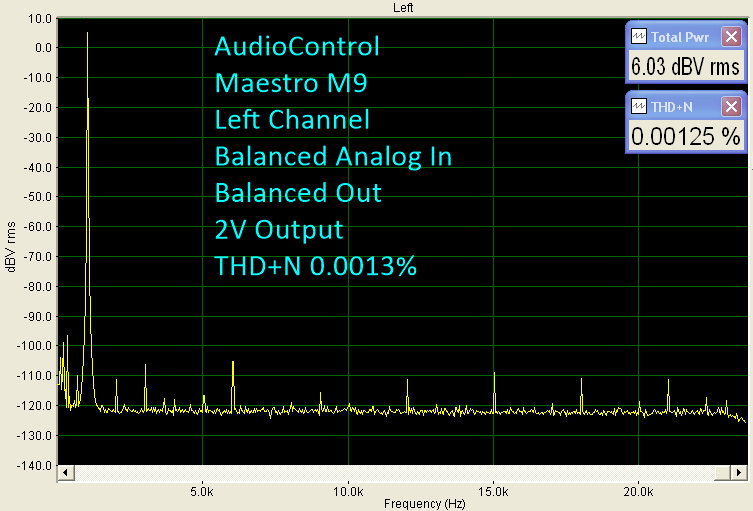
Below is the first of the IMD tests I do on preamplifiers/processors. The test signal comprises two simultaneous tones of the same amplitude, one is 19 kHz and the other is 20 kHz. The B-A peak is the difference signal that is sympathetic to the input signals, 1 kHz in this case. The Maestro M9 offers amazing performance with this B-A peak measured at 102.89 dB below the test signals.
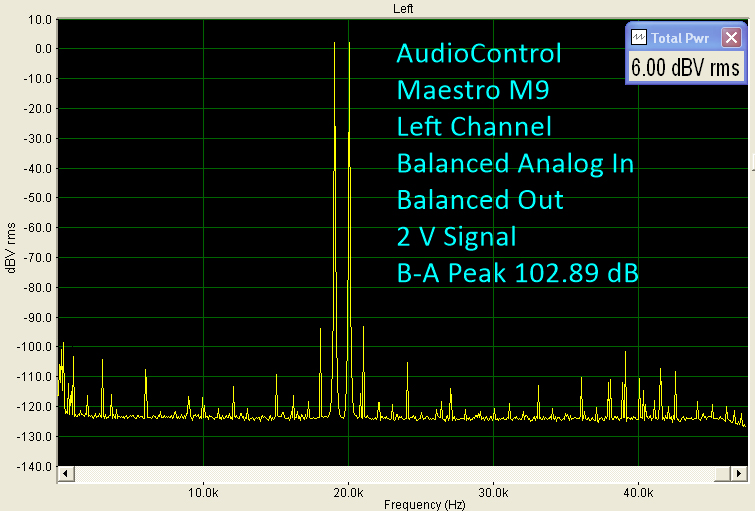
This is the other IMD test with 60 Hz and 7 kHz signals at a 4:1 amplitude ratio between these fundamental waveforms. The reported IMD at 2V was 0.0022%. Again, this is a sterling result for this class of product.
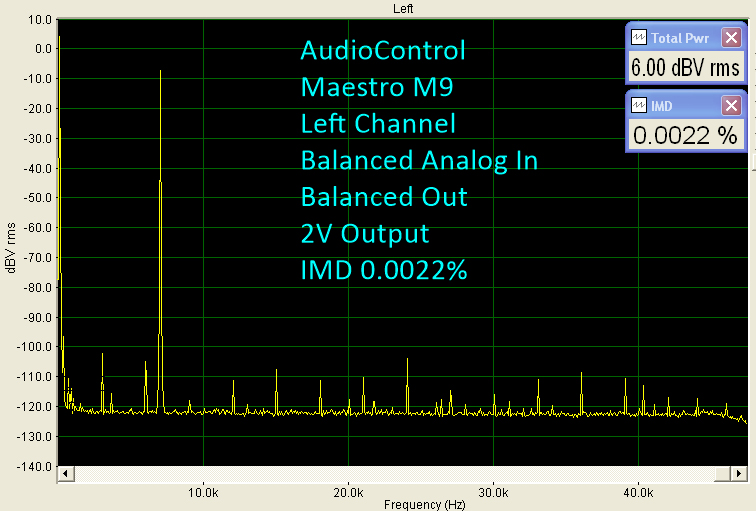
I also like to test the digital inputs using some basic signals. The below plot is a 1 kHz sine wave over the Blu ray HDMI input, output via the left channel balanced outs. Dirac Live was bypassed. The test signal was a 24-bit, 96 kHz PCM signal. The Maestro M9 delivered this signal at a THD + N reading of just 0.0008%. Not only does this match the Datasat RS 20i I tested, but it also exhibits even order harmonics which lends the signal a kind of tube like sound. This is quite the excellent test result!
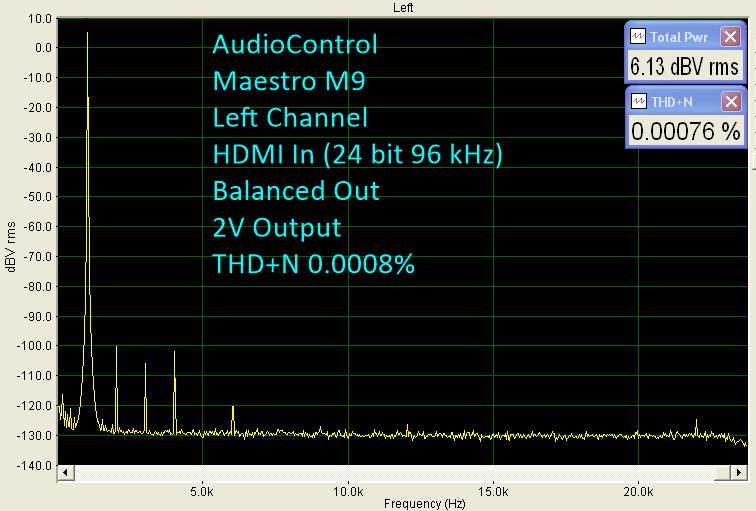
This next test was also a digital signal with the same set up described above. The B-A peak at 2.1V out was not quite as good as the analog test, coming out to 95.24 dB. This is nevertheless so far below the threshold of audibility as to be nothing more than an academic exercise.
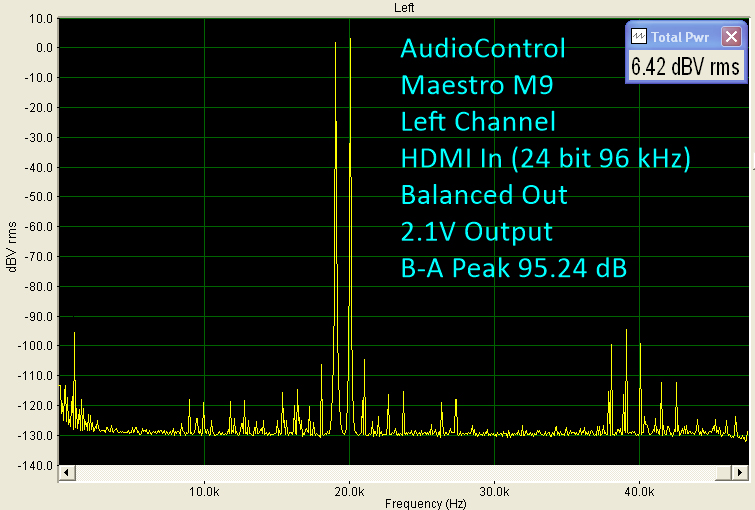
The last test plot of the AudioControl Maestro M9 is presented below. This was again a digital signal over HDMI at 24-bits and 96 kHz. The IMD at 2.1V was 0.0025% which is slightly more again than the analog test but still as excellent as one could expect from a complex surround processor such as this.

THE AUDIOCONTROL MAESTRO M9 Offers Excellent Audio Performance From Digital And Analog Sources Alike. I Also Found It To Be Ruggedly Built And Quite Reliable.
- Dolby Atmos and DTS:X ready
- Seamless surround envelope
- Midrange transparency
- UHD and 3D video passthrough
- Extreme musicality (especially for a surround product)
- Excellent processing for matrixed height channels
- Dirac Live room correction
- Pristine analog passthrough
- 5-year warranty
- More front-panel inputs: HDMI, S/PDIF, TOSLINK and/or USB
- Calibrated mic for room correction system
- Built-in WiFi
The AudioControl Maestro M9 strikes me as a professional grade piece of equipment.
Professionals demand that their equipment must be reliable. The Maestro M9 has a 5-year warranty.
Professionals also seek out products with excellent performance. The Maestro M9 has a massive power supply, upgraded DAC’s, well-designed analog circuits and Dirac Live.
A professional product should have some flexibility and the Maestro M9 has many inputs and outputs, it can be configured in many ways and it has compatibility with all the major integration and control systems for home automation.
The only part of the story where this product possibly falls short is with the soundcard and mic. The mic is reminiscent of the ones that you get with a mass market receiver. I wish they included a calibrated mic.
Professional products tend to be expensive and the AudioControl Maestro M9 ain’t cheap. This is a definite consideration, but keep in mind how cheapo most products have become these days. Not AudioControl, this thing is the real deal inside and out. That’s the cost of excellence. I say give it a listen and decide for yourself.


